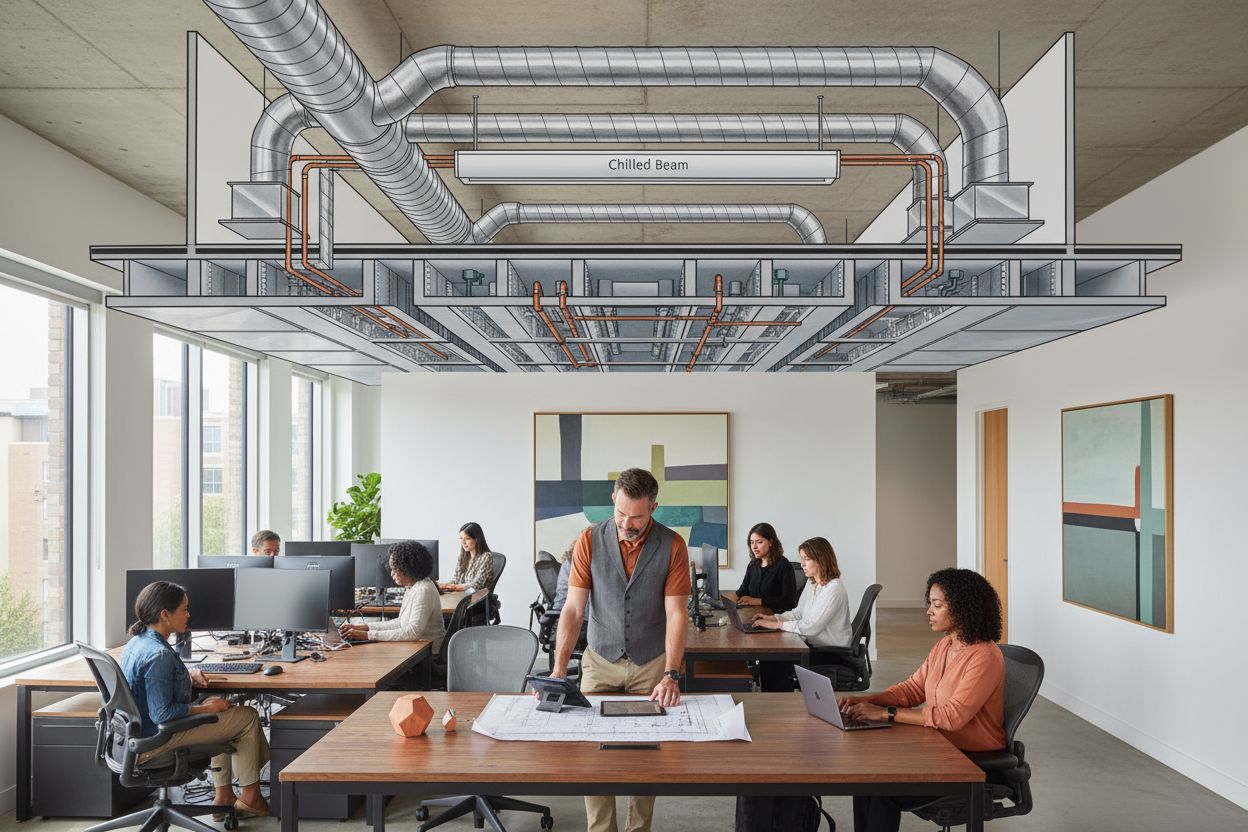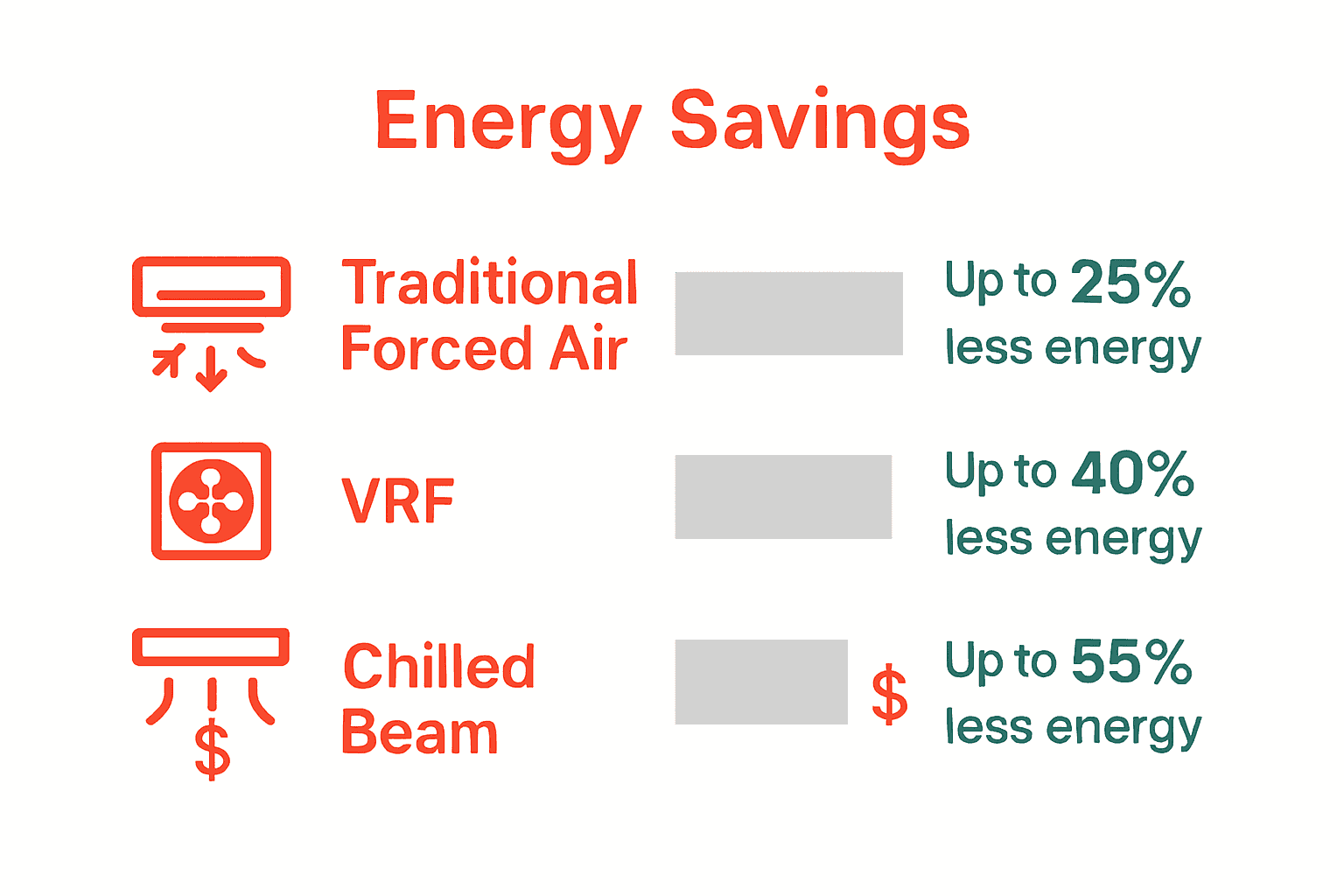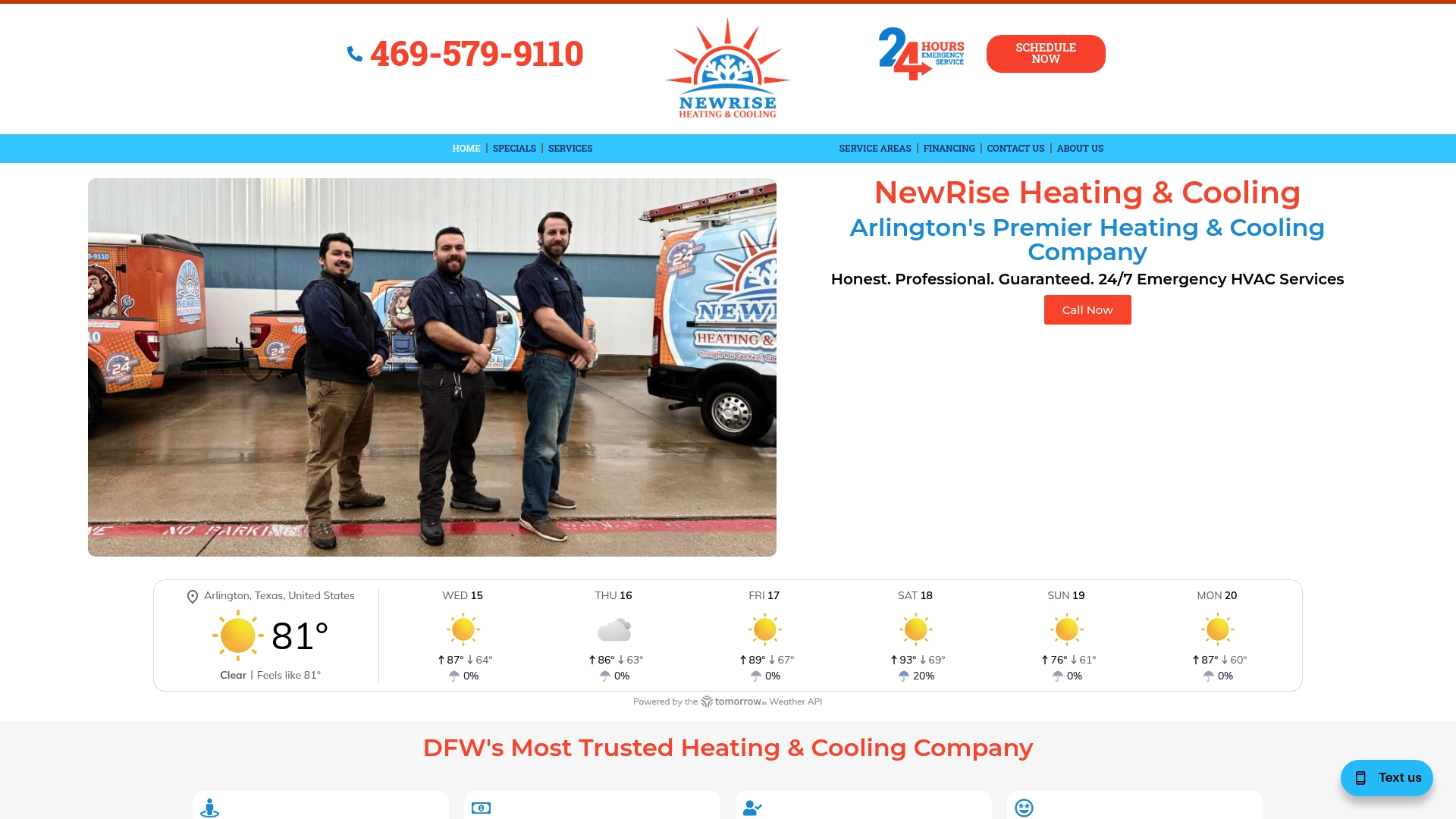Did you know that heating and cooling account for about 48% of the average home’s energy use in the United States? The heart of this system lies in your HVAC distribution network, which determines not only comfort but also energy bills and air quality. Understanding how these systems work helps you make smart choices about efficiency, cost, and long-term reliability for your living space.
Key Takeaways
| Point | Details |
| HVAC Distribution System Importance | A well-designed HVAC distribution system ensures comfort, air quality, and efficient temperature management in homes and buildings. |
| Types of Distribution Systems | Common systems include Forced Air, Variable Refrigerant Flow (VRF), Chilled Beam, and Underfloor Air Distribution (UFAD), each tailored to different needs and efficiency goals. |
| Energy Efficiency Advantages | Advanced systems like VRF and Chilled Beam can achieve significant energy savings—up to 55%—and lower operational costs over time. |
| Maintenance Needs | Regular maintenance, including filter changes and airflow optimization, is essential to prevent issues and ensure system efficiency and reliability. |
Table of Contents
What Are HVAC Distribution Systems?
An HVAC distribution system is the critical network responsible for moving conditioned air throughout your home or building, ensuring comfortable temperatures and optimal indoor air quality. Think of it like the circulatory system of your property – just as blood vessels transport oxygen, these systems transport heated or cooled air to every room.
At its core, an HVAC distribution system consists of several key components that work together seamlessly. According to research from Wikipedia, the air handler plays a central role, regulating and circulating air through ductwork. This crucial component includes multiple elements like:
-
Filters that clean incoming air
-
Coils for heating and cooling
-
Blowers that move air through the system
-
Dampers controlling airflow direction
Interestingly, modern HVAC technology offers innovative distribution strategies. Learn more about advanced HVAC solutions for your home. For instance, underfloor air distribution (UFAD) represents a cutting-edge approach that delivers conditioned air through a pressurized underfloor plenum. This method promotes better thermal stratification, improves ventilation efficiency, and can potentially reduce overall energy consumption.
Ultimately, a well-designed HVAC distribution system transforms raw heating and cooling potential into comfortable living spaces, managing temperature, humidity, and air quality with precision and reliability.
Types of HVAC Distribution Systems Explained
HVAC distribution systems come in various configurations, each designed to meet different building requirements and optimize comfort and energy efficiency. These systems can be broadly categorized into several innovative approaches that transform how we manage indoor climate.
Forced Air Distribution Systems
Forced air systems remain the most common type in residential and commercial spaces. These systems use air handlers and ductwork to circulate conditioned air throughout a building. Learn more about addressing heating challenges in your home, which can help you understand potential distribution system limitations.
Advanced Distribution Technologies
Some cutting-edge distribution technologies offer remarkable efficiency and flexibility:
-
Variable Refrigerant Flow (VRF) Systems: According to research from Wikipedia, VRF systems represent a sophisticated approach to air distribution. These systems can:
-
Distribute conditioned refrigerant to multiple indoor units
-
Provide individual zone temperature control
-
Enable heat recovery between different zones
-
Switch between heating and cooling modes
-
One remarkable advantage is their potential energy savings, with VRF systems achieving up to 55% reduction compared to conventional HVAC systems.
-
Chilled Beam Systems: Another innovative distribution method involves water-based heat exchange through ceiling-mounted coils. Research indicates these systems can:
-
Reduce airflow requirements by 60-80%
-
Lower overall energy consumption
-
Provide exceptionally quiet operation
-
Require minimal ceiling and duct space
-
Each distribution system offers unique benefits, and the right choice depends on your specific building design, climate, and performance requirements. Consulting with HVAC professionals can help you select the most appropriate solution for your specific needs.

Here’s a comparison of major HVAC distribution system types discussed above:
| System Type | How Air/Heat is Distributed | Key Advantages | Common Applications |
| Forced Air | Ductwork with fans/blowers | Widely available Quick temperature changes |
Homes Offices Retail |
| Variable Refrigerant Flow (VRF) | Refrigerant piped to multiple zones | Up to 55% energy savings Zone control Heat recovery |
Large homes Commercial buildings |
| Chilled Beam | Water-based ceiling coils | Quiet operation 60-80% less airflow Energy efficient |
Schools Hospitals Commercial |
| Underfloor Air Distribution (UFAD) | Air via raised floor plenum | Enhanced ventilation Thermal comfort Space-saving |
Modern offices Lecture halls |
How HVAC Distribution Systems Operate
HVAC distribution systems are complex networks that transform raw heating and cooling potential into comfortable indoor environments. At their core, these systems operate through a carefully choreographed process of air movement, conditioning, and circulation. Explore efficient HVAC solutions for your home to understand the intricacies of these sophisticated systems.
The Air Circulation Process
According to research from Wikipedia, air handlers are the heart of most HVAC distribution systems. These critical components follow a systematic approach:
-
Air Intake: Drawing air from return ducts
-
Conditioning: Passing air through heating or cooling coils
-
Filtration: Removing particles and improving air quality
-
Distribution: Pushing conditioned air through ductwork
Innovative Air Distribution Strategies
Modern systems employ advanced techniques to maximize comfort and efficiency. Underfloor Air Distribution (UFAD) represents a particularly innovative approach. As research indicates, these systems:
-
Supply conditioned air at floor level
-
Maintain air in the occupied zone
-
Create natural air stratification
-
Allow heated air to rise naturally
This method offers unique benefits. The heated air plumes rise, pushing warmer air to upper zones and creating a natural ventilation cycle that enhances overall comfort and energy efficiency.
Smaller spaces might utilize different configurations like fan coil units or rooftop packaged units, each designed to meet specific building requirements. The key is matching the distribution system to the unique needs of the space, ensuring optimal temperature control, air quality, and energy efficiency.
Key Features and Installation Standards in DFW
Installing an HVAC distribution system in the Dallas Fort Worth area requires meticulous attention to local mechanical codes and regional performance standards. Explore our comprehensive service areas to understand how these standards impact your specific location.
Regional Mechanical Code Requirements
According to local mechanical code research, DFW installations must adhere to specific performance and efficiency standards:
Fort Worth Mechanical Code Standards:
-
Maintain air conditioning systems in good condition
-
Ensure clean filters and unobstructed ducts
-
Maintain a 15–20 °F temperature differential between indoor and outdoor environments
Dallas Regional Installation Specifications:
-
Comply with International Energy Conservation Code
-
Follow manufacturer installation instructions precisely
-
Use UL-rated tapes or mastics for airtight duct joints
-
Install balancing dampers for optimal airflow
-
Apply duct insulation rated R-6 to R-8 based on specific location
Performance and Efficiency Considerations
Beyond code compliance, successful HVAC distribution system installation in DFW demands careful planning. Factors like local climate, building design, and energy efficiency goals play crucial roles. Proper duct sealing, insulation, and strategic component placement can significantly impact system performance.
Homeowners and contractors must work together to select distribution systems that not only meet local codes but also provide optimal comfort, energy efficiency, and long-term reliability. Professional assessment and expert installation remain key to achieving these objectives in the dynamic DFW metropolitan environment.
Energy Efficiency and Cost Considerations
Choosing an HVAC distribution system is about more than just temperature control—it’s a strategic investment in your home’s comfort and long-term financial health. Learn about energy-efficient HVAC solutions to understand how smart choices can transform your utility expenses.
Advanced Systems and Their Energy Savings
Cutting-edge HVAC distribution technologies offer remarkable potential for reducing energy consumption. According to research, two standout technologies demonstrate significant cost benefits:
Variable Refrigerant Flow (VRF) Systems:
-
Deliver up to 55% energy savings compared to conventional equipment
-
Utilize variable-speed operation for precise temperature control
-
Enable targeted zoning capabilities
-
Incorporate heat-recovery features for maximum efficiency
Chilled Beam Systems:
-
Reduce duct airflow requirements by 60-80%
-
Lower overall energy consumption
-
Supply targeted outdoor air
-
Proven track record of cost savings
Real-World Cost Impact
Research highlights the tangible financial benefits of advanced distribution systems. For instance, a university building successfully reduced HVAC costs by approximately 20% after implementing active chilled beam technology. This demonstrates that investing in sophisticated distribution systems isn’t just about comfort—it’s a strategic financial decision.
Ultimately, the most cost-effective HVAC distribution system balances initial installation expenses with long-term operational efficiency. Homeowners should consider factors like system complexity, maintenance requirements, and potential energy savings when making their selection.

Common Problems and Maintenance Solutions
HVAC distribution systems, despite their sophisticated design, can encounter a range of performance issues that impact home comfort and efficiency. Explore essential heater maintenance tips to stay ahead of potential problems and protect your investment.
Identifying Common HVAC Distribution Challenges
According to industry research, homeowners frequently encounter several recurring HVAC distribution system problems:
Critical System Issues:
-
Dirty/Clogged Filters: Restrict critical airflow
-
Malfunctioning Thermostats: Disrupt temperature control
-
Tripped Circuit Breakers: Interrupt system operation
-
Refrigerant Leaks: Compromise cooling efficiency
-
Dirty Coils: Reduce heat transfer capabilities
-
Water Leaks: Potential system and property damage
-
Unusual Noises: Indicate potential mechanical problems
DIY Maintenance and Prevention Strategies
Research suggests several proactive maintenance approaches to mitigate these common challenges:
- Filter Management:
-
Replace filters every 2-3 months
-
Check for consistent airflow
-
Inspect for visible dirt or blockages
- Airflow Optimization:
-
Balance distribution using system dampers
-
Clean air vents and ductwork
-
Address uneven temperatures through strategic insulation
While DIY maintenance can help, professional annual inspections remain crucial for comprehensive system health. These checkups can identify potential issues before they escalate into costly repairs, ensuring your HVAC distribution system operates at peak performance throughout the year.
Make Your HVAC Distribution Work Smarter for Your Home
Are you tired of uneven temperatures, high energy bills, or HVAC systems that just do not keep every room comfortable? This complete guide showed how HVAC distribution systems can impact every corner of your home and highlighted the frustration that comes with blocked airflow, dirty filters, and outdated components. At NewRise Heating and Cooling, we know that problems like poor air circulation, noisy equipment, and wasted energy are not just technical issues — they affect your family’s comfort and your monthly expenses.

If you want a home where every room feels just right and your energy bills stay under control, take action today. Trust a team that puts honesty and care first. Visit NewRise Heating and Cooling to discover how we bring lasting solutions through expert installation, regular maintenance, and customized upgrades. Your comfort cannot wait — let us help you design, repair, or upgrade your HVAC distribution system for quieter, cleaner, and truly reliable performance. Ready for a system that fits your family’s needs? Contact us now and let’s get started on your path to a healthier and more comfortable home.
Frequently Asked Questions
What are the key components of an HVAC distribution system?
An HVAC distribution system includes several key components such as air handlers, filters, heating and cooling coils, blowers, and dampers that work together to circulate conditioned air throughout a building.
How do forced air distribution systems operate?
Forced air distribution systems use air handlers and ductwork to circulate conditioned air. They draw air from return ducts, condition it by heating or cooling, filter it to improve air quality, and then distribute the air through the duct network into different rooms.
What are the advantages of Variable Refrigerant Flow (VRF) systems?
VRF systems offer significant advantages including individual zone temperature control, heat recovery between different zones, and the potential for up to 55% energy savings compared to conventional HVAC systems.
How can homeowners maintain their HVAC distribution systems effectively?
Homeowners can maintain their HVAC systems by regularly replacing filters every 2-3 months, ensuring proper airflow by cleaning vents and ducts, and scheduling professional annual inspections to identify and resolve potential issues.



